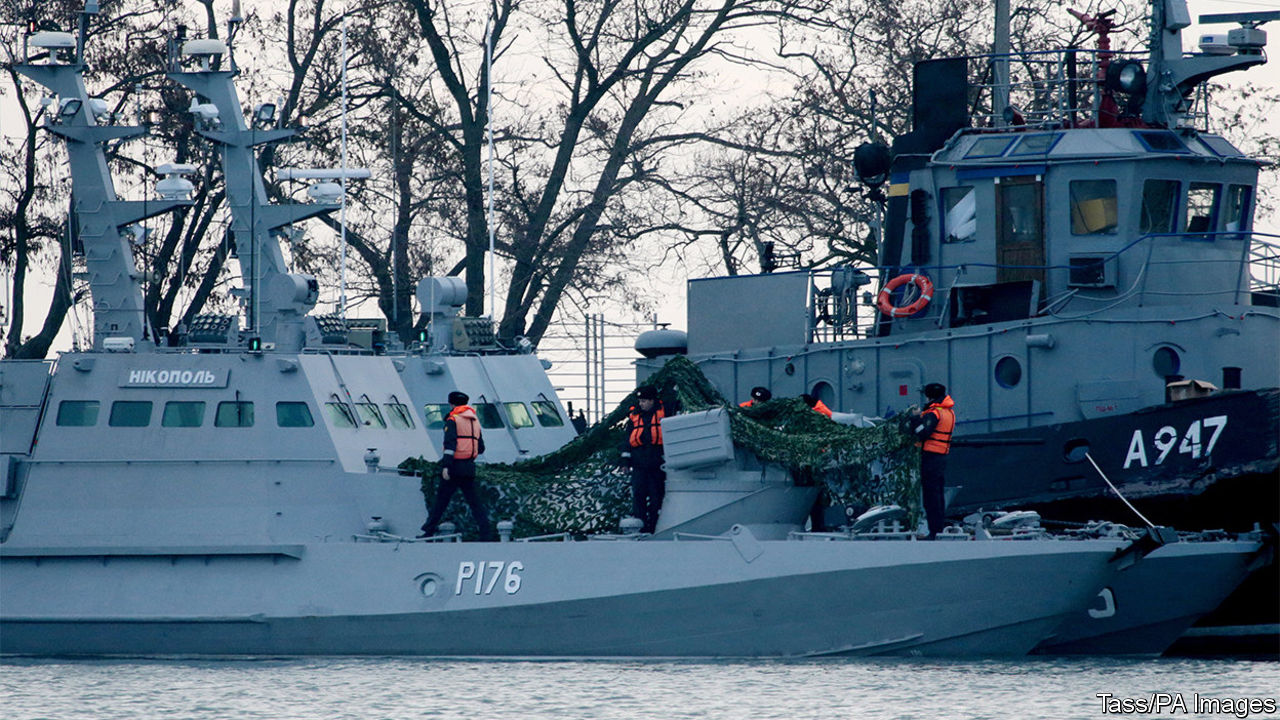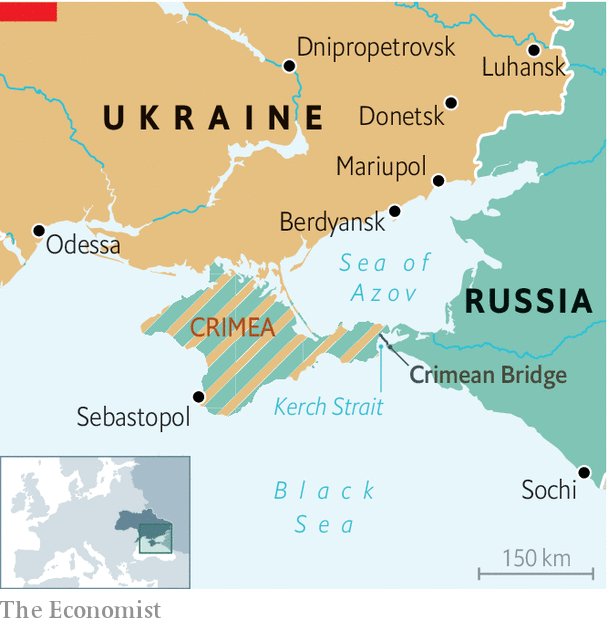
IN DIPLOMACY, building bridges is usually a good thing. But Russia’s Crimean Bridge, spanning the Kerch Strait between the Sea of Azov and the Black Sea (see map), has been more flashpoint than pacifier since it opened six months ago. On November 25th Russian forces shot, rammed and then seized two Ukrainian warships and a military tugboat sailing towards the bridge, and their ports beyond. Six sailors were wounded and 24 captured in the process. It marks the first time that Russia has owned up to an attack on Ukrainian forces, four years after its surreptitious invasion of eastern Ukraine and annexation of Crimea led to a war that has killed over 10,000 people, and still rages. On November 26th, as the country’s armed forces were placed on full alert and the United Nations Security Council prepared to meet, Ukraine’s president, Petro Poroshenko, called for martial law.
The crisis did not emerge from the blue. It is the culmination of six months of growing Russian pressure on Ukraine’s eastern ports, whose sole outlet to the Black Sea, and thence the Mediterranean and the world, has been steadily squeezed. In May Russia moved five ships, including artillery and missile boats, from its Caspian flotilla to the Sea of Azov, following Ukraine’s detention of a Russian fishing boat there on March 25th. Russia’s Federal Security Service (FSB) and coast guard have since detained scores of Ukrainian and international merchant ships for hours and even days at a time—over 140 between May and August alone—in what amounts to an undeclared blockade. Russia’s decision briefly to park a tanker across the Kerch Strait after the clash was a less than subtle reminder of this tightening noose.

Russia’s hyperactive naval policing exploits powers granted under a 2003 agreement between Russia and Ukraine, signed long before Ukraine’s pro-Russia regime was toppled, which established joint control of the Sea of Azov. The detentions, delays and uncertainty have strangled Ukrainian ports like Mariupol, the country’s third-largest, and Berdyansk. The Crimean Bridge itself has paralysed 144 of the biggest ships that once called at Mariupol but are too tall to slip under its 33-metre structure. Shipping in and out of one of Ukraine’s principal ports has fallen by a quarter. Meanwhile Ukraine is in no position to fight back. It lost up to 80% of its navy when Crimea was snatched in 2014, and the most formidable vessel of Mariupol’s coast guard is an old fishing boat confiscated from Turkish poachers. It has turned instead to legal counter-attacks, making forlorn appeals to international tribunals.
Some Ukrainians fear that the muscle-flexing is a prelude to an amphibious assault on Ukraine’s eastern coastline, which would create a more robust land corridor from Russia to isolated Crimea. Mr Poroshenko, addressing the nation on television on November 26th, also claimed to have received intelligence pointing to a fresh Russian ground offensive. What is more likely than such acts of outright war is that Russia is ramping up pressure to force concessions, such as the restoration of the water supply from Ukraine’s mainland to Crimea, which was largely cut in 2014.
Mr Poroshenko, who faces presidential elections next spring, is unlikely to give much ground. Although President Donald Trump has remained silent, instead attacking European allies on the day of the clash, Ukraine’s other partners have lent it verbal support, with both the EU and NATO demanding that Russia restore freedom of navigation through the Kerch Strait—though there are also likely to be reservations over the implications of any declaration of martial law. Mr Poroshenko will be waiting anxiously to see whether this translates into tangible help in the shape of tougher economic sanctions on Russia, a steadier flow of military advisers or even much-needed gunboats to replenish his now-depleted fleet.








